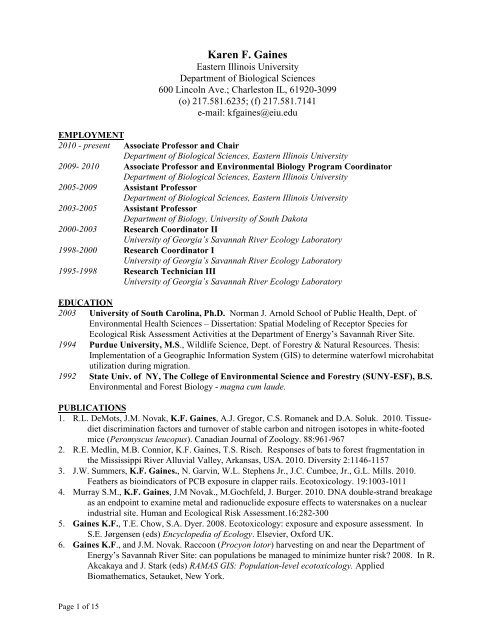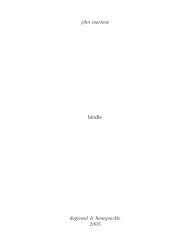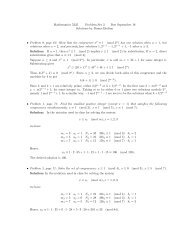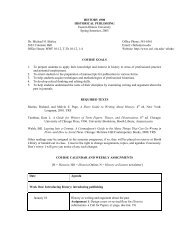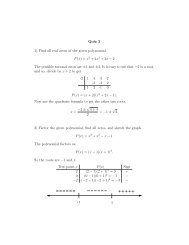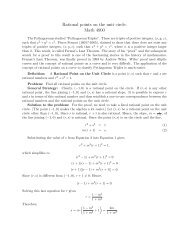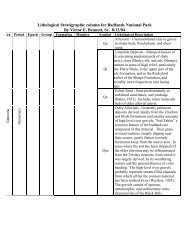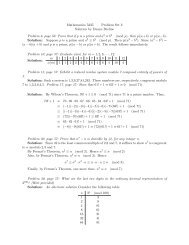Karen F. Gaines - Eastern Illinois University
Karen F. Gaines - Eastern Illinois University
Karen F. Gaines - Eastern Illinois University
Create successful ePaper yourself
Turn your PDF publications into a flip-book with our unique Google optimized e-Paper software.
CV: <strong>Karen</strong> F. <strong>Gaines</strong>24. Lord C.G., K.F. <strong>Gaines</strong>, C.S. Boring, I.L. Brisbin, Jr., M. Gochfeld and J. Burger. 2002. Raccoon(Procyon lotor) as a bioindicator of mercury contamination at the U.S. Department of Energy’sSavannah River Site. Archives of Environmental Contamination and Toxicolology. 43:356-363.25. Burger J., K.F. <strong>Gaines</strong>,W. L. Stephens, C. S. Boring J. Snodgrass,C. Dixon, M. McMahon, S.Shukla, T. Shukla, and M. Gochfeld. 2002. Metal levels in fish from the Savannah River:potential hazards to fish and other receptors. Environmental Research. 89:85-97.26. Burger J., K.F. <strong>Gaines</strong>, C.S. Boring, W.L. Stephens, Jr., J. Snodgrass, and M. Gochfeld. 2001.Mercury and selenium in fish from the Savannah River: species, trophic level and locationaldifferences. Environmental Research. 87:108-118.27. Burger J., K.F. <strong>Gaines</strong>, M. Gochfeld. 2001. Ethnic differences in risk from mercury amongSavannah River fisherman. Risk Analysis. 21:533-544.28. Burger J., K.F. <strong>Gaines</strong>, C.G. Lord, I.L. Brisbin, Jr., S. Shulka, and M. Gochfeld. 2001. Metal levelsin raccoon tissues: differences on and off the Departments of Energy’s Savannah River Site inSouth Carolina. Environmental Monitoring and Assessment. 74:67-84.29. Burger J., K.F. <strong>Gaines</strong>, J. Peles, W. L. Stephens Jr, C. Shane Boring, I. L. Brisbin Jr, J. Snodgrass,A. L. Bryan, Jr., M. H. Smith, and M. Gochfeld. 2001. Radiocesium in fish from the SavannahRiver and Steel Creek: potential food chain exposure to the public. Risk Analysis. 21:545-559.30. Romanek C.S., K.F. <strong>Gaines</strong>, A.L. Bryan, Jr. and I.L. Brisbin, Jr. 2000. Foraging ecology of theendangered wood stork recorded in the stable isotopes signature of feathers. Oecologia. 125:584-594.31. Burger J., C.G. Lord, E.J. Yurkow, L. McGrath, K.F. <strong>Gaines</strong>, I.L. Brisbin, Jr. and M Gochfeld.2000. Metals and metallothionein in the liver of raccoons: utility for environmental assessmentand monitoring. Journal of Toxicology and Environmental Health. 60:243-261.32. <strong>Gaines</strong> K.F., A.L. Bryan, Jr., and P.M. Dixon. 2000. The effects of drought on foraging habitatselection of breeding wood storks in coastal Georgia. Waterbirds. 23:64-73.33. <strong>Gaines</strong> K.F., C.G. Lord, C.S. Boring, I.L. Brisbin, Jr., M. Gochfeld and J. Burger. 2000. Raccoons aspotential vectors of radionuclide contamination to human food chains from a nuclear industrialsite. Journal of Wildlife Management. 64:199-208.34. White D.L., and K.F. <strong>Gaines</strong>. 2000. The Savannah River Site: site description, land use andmanagement history. Pages 8-17 in J. B. Dunning and J. C. Kilgo, eds. Avian studies at theSavannah River Site: a model for integrating basic research and long-term management. StudiesIn Avian Biology 21.35. Kennamer R.A., I.L. Brisbin, Jr., K.F. <strong>Gaines</strong>, and W.L. Stephens, Jr. 1999. Temporal and spatialpatterns of avifauna on wetlands in the vicinity of Bush Field Airport, Augusta Georgia, USA.Proceedings of the 1999 Joint Meeting of Birdstrike Committee USA / Birdstrike CommitteeCanada.36. Burger J., J. Sanchez, J.W. Gibbons, T. Benson, J. Ondrof, R. Ramos, M.J. McMahon, K.F. <strong>Gaines</strong>,C.G. Lord, and M. Gochfeld. 1999. Attitudes and perceptions about ecological resources andhazards of people living around the Savannah River Site. Environmental Monitoring andAssessment 57: 195-211.37. <strong>Gaines</strong> K.F., A.L. Bryan, Jr., P.M. Dixon and M.J. Harris. 1998. Foraging habitat use by woodstorks nesting in the coastal zone of Georgia, USA. Colonial Waterbirds. 21:1-10.38. Brisbin I.L., Jr., C.H. Jagoe, K.F. <strong>Gaines</strong> and J.C. Gariboldi. 1998. Environmental contaminants asconcerns for the conservation biology of Crocodilians. Proceedings of the 14 th Working Meetingof the IUCN/SSC Crocodile Specialist Group. IUCN. Gland, Switzerland.39. Brisbin I.L., Jr., K.F. <strong>Gaines</strong>, C.H. Jagoe and P.A. Consolie. 1996. Population studies of Americanalligators inhabiting a reservoir: long-term responses to drawdown and subsequent refill.Proceedings of the 13 th Working Meeting of the IUCN/SSC Crocodile Specialist Group. IUCN.Gland, Switzerland.Page 3 of 12
CV: <strong>Karen</strong> F. <strong>Gaines</strong>40. Brisbin I.L., Jr., K.F. <strong>Gaines</strong>, and W.L. Stephens, Jr. 1997. A spring encounter with a white-frontedgoose in South Carolina. The Chat 1997.GRANTS AWARDEDExtramural1. A Comprehensive Risk Assessment Model for the Tims Branch – Steed Pond System. C.S.Romanek., A.L. Bryan, K.F. <strong>Gaines</strong>, J.M. Novak, H.A. Brant. 2009. Washington SavannahRiver Company. $270,000, In Progress.2. Development of a Predictive 137Cs Toxicokinetic Model to Define Areas of High Risk for WhitetailedDeer Harvest on the Department of Energy’s Savannah River Site. 2009. K.F. <strong>Gaines</strong>,J.M. Novak. Washington Savannah River Company. $33,000, completed.3. Intensive Basin Survey Assistance. 2008. K.F <strong>Gaines</strong>, R.U. Fischer. <strong>Illinois</strong> EPA. $16,121,completed.4. IBHE Cooperative Work Study Program (Grant Coordinator). 2008. Allocation for EnvironmentalBiology Program: $14,000, completed.5. Development of a Predictive 137 Cs Toxicokinetic Model to Define Areas of High Risk for GameHarvest on the Department of Energy’s Savannah River Site. 2007. K.F. <strong>Gaines</strong>, J.M. Novak.Washington Savannah River Company. $45,668, completed.6. Use of Mineralized Tissues as Indicators of the Effects of Environmental Contamination. 2007. A.Rodriguez-Navarro, A. Almendros-Gallego, Weng-Guo Wang, A. Yebra-Rodriguez, C.Romanek, K.F. <strong>Gaines</strong>. Funding agency: Ministerio de Educación y Ciencia. (Spain). Amountfunded: 55.000 euros. Completed.7. Factors Influencing Plague in the Black-tailed Prairie Dog. 2004. H. Britten, K.F. <strong>Gaines</strong>, L.Washburn, M. Price. South Dakota Center for Biocomplexity: National Science FoundationAward: $110,000, completed.8. Spatial Modeling of Receptor Species for Ecological Risk Assessment Activities at the SRS. 2003.K.F. <strong>Gaines</strong>, J.M Novak, Department of Energy – Environmental Restoration. Award $65,000,completed.9. Contaminant Exposure Spatial Statistical Modeling. 2002. K.F. <strong>Gaines</strong> and M.D. Wilson. 2003Department of Energy – Environmental Restoration. Award $60,000, completed.10. Using Small Mammals as Indicator Species of Environmental Health for the Missouri NationalRecreational River Corridor: A Study of Individual, Population and Community Level Effects.2003 J.M. Novak and K.F. <strong>Gaines</strong>. MRI Pilot Award. $20,915, completed.11. Environmental Monitoring of The Missouri National Recreational River Corridor: An AmphibianSurvey to Identify Indicator Species Appropriate For Assessing Environmental Health. 2003.K.F. <strong>Gaines</strong> and J.M. Novak. MRI Pilot Award. $20,910, completed.12. River Otter Data Collection for Spatially Explicit Risk Assessment Modeling. 2002. J.M. Novak andK.F. <strong>Gaines</strong>. Department of Energy – Environmental Restoration. Award $43,500, completed.13. Spatial Modeling of Receptor Species for Ecological Risk Assessment Activities at the SRS. 2000-2003. K.F. <strong>Gaines</strong>, J.W Snodgrass, R.A. Kennamer, A.L. Bryan, Jr. J. Peles, J.M Novak, G.R.Wein, and I.L. Brisbin, Jr. Department of Energy – Environmental Restoration. Award $200,000,completed.14. Bioavailability and Trophic Transfer of Uranium and Nickel in A/M Area. 2002. T. Punshon, A.Sowder, K.F. <strong>Gaines</strong> and P.M. Bertsch. Department of Energy – Environmental RestorationAward $275,000, completed.15. Tritium Burdens in Key Receptor Species at a Mixed Waste Management Facility. 2002. K.F.<strong>Gaines</strong> and J.C. Seaman. Department of Energy – Environmental Restoration. Award $28,000,completed.16. Enhancement of the Wildlife Survey GIS Database Project. 2002. K.F. <strong>Gaines</strong>, D.J. Karapatakis andC.E. Davis. Department of Energy – Environmental Restoration Award $20,000, completed.Page 4 of 12
CV: <strong>Karen</strong> F. <strong>Gaines</strong>17. Contaminants and Risk at the SRS. 2002. K.F. <strong>Gaines</strong>, J.M. Novak and I.L. Brisbin, Jr. CRESP -Rutgers <strong>University</strong>. Award $22,000, completed.18. Studies of Foraging Patterns of Clapper Rails in Contaminated and Uncontaminated Salt MarshEcosystems. 2001. K.F. <strong>Gaines</strong> and I.L. Brisbin, Jr. Savannah Presbytery M.K. PentecostEcology Fund Grant. Award $7,000, completed.19. Clapper Rail Egg Collections for USFWS Mercury Dose Experiment. 2002. K.F. <strong>Gaines</strong>, J.C.Cumbee, Jr., and I.L. Brisbin, Jr. U.S. Fish and Wildlife Service. Award $5,000, completed.20. Clapper Rail Egg Collections for USFWS Mercury Dose Experiment. 2001. K.F. <strong>Gaines</strong>, W.L.Stephens, Jr., and I.L. Brisbin, Jr. U.S. Fish and Wildlife Service. Award $7,300, completed.21. Contaminants and Risk at the SRS. 2001. K.F. <strong>Gaines</strong> and I.L. Brisbin, Jr. CRESP - Rutgers<strong>University</strong>. $32,900, completed.22. Comparison of Clapper Rail Eggshell Integrity from Contaminated and Uncontaminated Salt MarshSystems. 2001. A. Rodriguez-Navarro, K.F. <strong>Gaines</strong>, C.S. Romanek, and I.L. Brisbin, Jr. U.S.Fish and Wildlife Service. Award $11,000, completed.23. Determination of Contaminant Burdens in Clapper Rails Inhabiting the Blythe Island and LCP SaltMarsh Systems, Brunswick, GA. 2001. K.F. <strong>Gaines</strong>, W.L. Stephens, Jr., G.L. Mills, B.P.Jackson, and I.L. Brisbin, Jr. U.S. Fish and Wildlife Service. Award $40,291, completed.24. Enhancement of the Wildlife Survey GIS Database Project. 2000. K.F. <strong>Gaines</strong>, H. Wiggins-Brown,D.J. Karapatakis, G.R. Wein, and I.L. Brisbin, Jr. Westinghouse Savannah River Company –Environmental Restoration. Award $32,274, completed.25. Maintenance and Update of the Wildlife Survey Project. 2000. H. Wiggins-Brown, D.J. Karapatakis,G.R. Wein, K.F. <strong>Gaines</strong>. Westinghouse Savannah River Company – Environmental Restoration.Award $12,180, completed.26. Clapper Rail Hatchilibility Success. 2000. K.F. <strong>Gaines</strong>, W.L. Stephens, Jr., T.C. Glenn, J.M. Novakand I.L. Brisbin, Jr. U.S. Fish and Wildlife Service. Award $34,000, completed.27. Determination of Contaminant Burdens and DNA Strand Breakage in Clapper Rails Inhabiting theTroupe Creek and LCP Salt Marsh Systems, Brunswick, GA. 1999. K.F. <strong>Gaines</strong>, W.L. Stephens,Jr., T.C. Glenn, J.M. Novak, G.L. Mills and I.L. Brisbin, Jr. U.S. Fish and Wildlife Service.Award $46,000, completed.28. Abundance and Distribution Patterns of Avifauna on Wetlands in the Vicinity of Bush Field Airport:1999-2000. 1999. R.A. Kennamer, I.L. Brisbin, Jr., K.F. <strong>Gaines</strong>, and W.L. Stephens, Jr. Augusta– Richmond County Consolidated Government. Award $75,000, completed.29. Clapper Rail Hatchilibility Success. 1999. K.F. <strong>Gaines</strong>, W.L. Stephens, Jr., and I.L. Brisbin, Jr. U.S.Fish and Wildlife Service. Award $11,000, completed.30. Foraging Habitat use by Wood Storks in South-Central Georgia. 1998. A.L. Bryan, Jr., K.F. <strong>Gaines</strong>,and I.L. Brisbin, Jr. Georgia Department of Natural Resources, [USFWS Section 6 funds].Award $18,000, completed.31. Wildlife Survey for Ecological Risk Assessment Activities at the SRS. 1998. K.F. <strong>Gaines</strong>, D.J.Karapatakis, M.H. Smith, and G.R. Wein. Westinghouse Savannah River Company –Environmental Restoration. Award $63,982, completed.32. Abundance and Distribution Patterns of Avifauna on Wetlands in the Vicinity of Bush Field Airport:1998-1999. 1998. R.A. Kennamer, I.L. Brisbin, Jr., K.F. <strong>Gaines</strong>, and W.L. Stephens, Jr. Augusta– Richmond County Consolidated Government. Award $65,000, completed.33. Wood Stork Foraging Ecology in South-Central Georgia. 1998. A.L. Bryan Jr. K.F. <strong>Gaines</strong>, and I.L.Brisbin, Jr.. Georgia Dept. of Natural Resources. Award $17,984, completed.34. Movement Patterns of Wood Storks in the Georgia coastal zone. 1997. A.L. Bryan, Jr., K.F. <strong>Gaines</strong>,and I.L. Brisbin, Jr. U.S. Fish and Wildlife Service, Savannah Coastal Refuges, Savannah, GA.Award: $23,992, completed.35. DeGray’s Lake Hydrologic GIS Model. 1997. K.F. <strong>Gaines</strong>, and I.L. Brisbin Jr. Arkansas Fish andGame Commission. Award: $17,000, completed.Page 5 of 12
CV: <strong>Karen</strong> F. <strong>Gaines</strong>36. Wood Stork Foraging Ecology in Coastal Georgia. 1997. A.L. Bryan Jr., K.F. <strong>Gaines</strong>, and I.L.Brisbin Jr. Georgia Dept. of Natural Resources (USFWS Section 6 funds). Award: $20,000,completed.37. Inventory of Wading Bird Colonies in Georgia’s Coastal Plain in 1996. 1996. A.L. Bryan Jr., K.F.<strong>Gaines</strong>, and I.L. Brisbin Jr. Georgia Dept. of Natural Resources. Award: $27,880, completed.<strong>Eastern</strong> <strong>Illinois</strong> <strong>University</strong> - Intramural1. FY09 Redden Fund Grant. “Environmental Testing Kits for Hands-on Learning” - $1,400.2. FY08 Faculty Research and Creativity Support Grant “Can an enzyme-linked immunosorbant assay(ELISA) detect polychlorinated biphenyl’s (PCBs) in bird feathers?” – $2,7003. Summer Research/ Creative Activity Award. April 2007. “Does the LCP Superfund site cause anabnormal age structure in Clapper Rail population?” - $4,000.4. FY07 Redden Fund Grant. “Enhancement of GIS Curriculum” - $1,500.5. Early Research Support Grant Award. November, 2006. Travel Funds to “The 2006 Wildlife SocietyAnnual Conference” - $500.6. Summer Research/ Creative Activity Award. April 2006. “Is the LCP Superfund site an ecologicaltrap?” - $4,000.7. Seed Grant Award – College of Sciences. February, 2006. “Clapper Rail Feather Analyses” - $1,0008. Small Grant Program. November, 2005. Travel Funds to “The Wildlife Society Twelfth AnnualConference” - $245.REPORTS / DELIVERABLES1. Spatiotemporal-Toxicodynamic modeling of 137 Cs to estimate white-tailed deer background levels forthe Department of Energy’s Savannah River Site. 2009. K.F. <strong>Gaines</strong> and J.M. Novak. Report toU.S. Department of Energy. US Document No.: SRNS-RP-2009-012832. Toxicodynamic modeling of 137 Cs to estimate white-tailed deer background levels for the Departmentof Energy’s Savannah River Site. 2008. K.F. <strong>Gaines</strong> and J.M. Novak. Report to U.S.Department of Energy. US Document No.: WSRC-RP-2008-4073, Rev. 0.3. A Spatially Explicit model of the Wild Hog (Sus scrofa) for Ecological Risk Assessment Activities atthe Department of energy’s Savannah River Site. 2002. K.F. <strong>Gaines</strong>. CD ROM SREL-68, UC-66e. Savannah River Ecology Laboratory.4. Habitat Specific Models of Wood Duck Nest Box Use for the Department of Energy’s SavannahRiver Site. 2002. R.A. Kennamer and K.F. <strong>Gaines</strong>. CD ROM SREL-67, UC-66e. SavannahRiver Ecology Laboratory.5. A Spatially Explicit Model for the Cotton Rat (Sigmodon hispidus) Habitat Preference on theDepartment of Energy’s Savannah River Site. 2002. J.M. Novak, J.D Peles, and K.F. <strong>Gaines</strong>.CD ROM SREL-64, UC-66e. Savannah River Ecology Laboratory.6. Spatial Explicit Model of Beaver Habitat Preference in SRS Streams. 2002. J.W. Snodgrass, A.Jakes, K.F. <strong>Gaines</strong>, and J. Burger. CD ROM SREL-63, UC-66e. Savannah River EcologyLaboratory.7. Spatial Modeling of the Raccoon (Procyon lotor) for Ecological Risk Assessment Activities at theDepartment of Energy’s Savannah River Site. 2001. K.F. <strong>Gaines</strong>. CD ROM SREL-62, UC-66e.Savannah River Ecology Laboratory.8. Enhancement of the Wildlife Survey GIS Database Final Report. 2001. K.F. <strong>Gaines</strong>, D.J.Karapatakis, G.R. Wein. Westinghouse Savannah River Company – Environmental Restoration.9. Determination of Contaminant Burdens, DNA Strand Breakage and Nesting Success in Clapper RailsInhabiting the Salt Marsh Estuary in Brunswick, GA - PART I&II. 2000. K.F. <strong>Gaines</strong>, J.M.Novak, W.L. Stephens, Jr. and J.C. Cumbee, Jr. Report to the U.S. Fish and Wildlife Service.10. Abundance and Distribution Patterns of Avifauna on Wetlands in the Vicinity of Bush Field Airport:1999-2000 including GIS Habitat Coverages and Aerial Survey Data. 2000. R.A. Kennamer, I.L.Page 6 of 12
CV: <strong>Karen</strong> F. <strong>Gaines</strong>Brisbin, Jr., K.F. <strong>Gaines</strong> and W.L. Stephens, Jr. Report to Augusta – Richmond CountyConsolidated Government.11. Wildlife GIS Survey for Ecological Risk Assessment Activities on the SRS. 1999. K.F. <strong>Gaines</strong>, D.J.Karapatakis, G.R. Wein. Final Report to Westinghouse Savannah River Company –Environmental Restoration. CD-ROM SREL-59, UC-66-e. Savannah River Ecology Laboratory.12. Foraging Habitat Utilization by Breeding Wood Storks in South-Central Georgia in 1999. 1999 A.L.Bryan, Jr. and K.F. <strong>Gaines</strong>. Report to the Georgia Department of Natural Resources Nongame-Endangered Species Program.13. Clapper Rail Egg Hatchibility From The Troupe Creek Salt Marsh System. 1999. K.F. <strong>Gaines</strong> andW.L. Stephens, Jr. Report to the U.S. Fish and Wildlife Service.14. Abundance and Distribution Patterns of Avifauna on Wetlands in the Vicinity of Bush Field Airport:1998-1999 including GIS Habitat Coverages and Aerial Survey Data. 1999. R.A. Kennamer, I.L.Brisbin, Jr., K.F. <strong>Gaines</strong> and W.L. Stephens, Jr. Report to Augusta – Richmond CountyConsolidated Government.15. Wood Stork Movement and Roost Utilization Patterns in the Coastal Zone of Georgia in 1997 and1998. 1998 A.L. Bryan, Jr. and K.F. <strong>Gaines</strong>. Report to the U.S. Fish and Wildlife Service,Savannah Coastal Refuges, Savannah, GA.16. Development of a Spatially explicit Model Using a Geographic Information System (GIS) in Supportof Research Efforts to Investigate the Cause of Eagle and Waterfowl Deaths at the DeGray’sLake Reservoir. 1998. K.F. <strong>Gaines</strong>, I.L. Brisbin, Jr. Report to Wildlife Management Division,Arkansas Game and Fish Commission.17. Foraging Habitat use by Breeding Storks in the Coastal Zone of Georgia in 1997. 1997. A.L. Bryan,Jr., and K.F. <strong>Gaines</strong>. Report to the Georgia DNR, Nongame-Endangered Species Program,Brunswick, GA (U.S. Fish & Wildlife Service Section 6 funds).18. Inventory of Wading Bird Colonies in Georgia’s Coastal Plain. 1996. A.L. Bryan, Jr., and K.F.<strong>Gaines</strong>. Report to the Georgia DNR, Nongame-Endangered Species Program, Brunswick, GA.PRESENTATIONS1. The 2009 Wildlife Society Annual Conference (Nov. 2009) “A Spatially Explicit Model to PredictWhite-tailed Deer Radiocesium Body Burdens on the Department of Energy’s Savannah RiverSite.” C. W. Bobryk, K. F. <strong>Gaines</strong>, J. M. Novak and S. S. Dyer.2. The 2008 Wildlife Society Annual Conference (Nov. 2008) “The use of feathers as temporalbioindicators of PCB exposure in Clapper Rails.” J.W. Summers, K.F. <strong>Gaines</strong>, N. Garvin, G.L.Mills.3. The 2008 Wildlife Society Annual Conference (Nov. 2008) “An overview of hurricanetoxicodynamics.” K.F. <strong>Gaines</strong>4. The 2008 Wildlife Society Annual Conference (Nov. 2008) “Using feathers to monitor PAHexposure in birds.” K.F. <strong>Gaines</strong>, B. Goatcher, S. Rush, G.L. Mills.5. The 2008 Wildlife Society Annual Conference (Nov. 2008) “Using stable isotopes to infer seasonaldietary changes and niche separation between deer mice and white-footed mice in southeasternSouth Dakota.” R.L. DeMots, J.M. Novak, K.F. <strong>Gaines</strong>, C.S. Romanek.6. 68 th Midwest Fish & Wildlife Conference (Dec. 2007) “What are appropriate chronic exposureendpoints? DNA strand breakage and eggshell integrity in clapper rails at the LCP site.” J. M.Novak, K.F. <strong>Gaines</strong>7. 68 th Midwest Fish & Wildlife Conference (Dec. 2007) “Relationship among geomorphology and fishassemblages in eastern <strong>Illinois</strong> streams.” J.D. Fore, R.U. Fischer, K.F. <strong>Gaines</strong>, V.P. Gutowski.8. 68 th Midwest Fish & Wildlife Conference (Dec. 2007) “Assessment of stream valley segments asdeterminants of stream habitat quality.” S.S. Warner, R.U. Fischer, C.L. Pederson, K.F. <strong>Gaines</strong>.9. The 2007 Wildlife Society Annual Conference (Sept. 2007) “Using stable carbon and nitrogenisotopes to infer seasonal dietary changes and niche separation between deer mice and white-Page 7 of 12
CV: <strong>Karen</strong> F. <strong>Gaines</strong>footed mice in southeastern South Dakota.” R.L. DeMots, J.M. Novak, K.F. <strong>Gaines</strong>, A. J.Gregor, C. S. Romanek.10. The 2007 Wildlife Society Annual Conference (Sept. 2007) “Stable carbon and nitrogen isotopicdiet-tissue discrimination factors and turnover rates in the North American bullfrog.” A.J.Gregor, K.F. <strong>Gaines</strong>, J.M. Novak, R.L. DeMots, C.S. Romanek.11. The 2006 Wildlife Society Annual Conference (Sept. 2006) “Is the LCP superfund site an ecologicaltrap? A case study using the clapper rail” K.F. <strong>Gaines</strong>, J.M Novak, G.L. Mills.12. The 2006 Wildlife Society Annual Conference (Sept. 2006) “What are appropriate chronic exposureendpoints within an ecological trap? DNA strand breakage in clapper rails at the LCP site” J.MNovak, K.F. <strong>Gaines</strong>.13. 67 th Midwest Fish & Wildlife Conference (Dec. 2006) “Atrazine in agricultural runoff and itsimpacts on two anuran species in central <strong>Illinois</strong>. L.M. Gross, K.F. <strong>Gaines</strong>, S.J. Mullin.14. Joint Meeting of Ichthyologists and Herpetologists, New Orleans, LA. (July 2006) “Red-eared slidersas long-term indicators of environmental contamination over time” E.D.Casey, P.M. Bertsch,K.F. <strong>Gaines</strong>, J.M. Novak, , W.L. Stephens, Jr.15. Mycological Society of America, (Aug 2006). “Macrofungi associated with tree windfall in oldgrowth prairie groves” K. Vernier, V.P. Hustad, A.S. Methven, S.J. Meiners, K.F. <strong>Gaines</strong>, A.N.Miller.16. The Association of Southeastern Biologists 67 th Annual Meeting, Gatlinburg, TN (April 2006).“Macrofungi associated with tree windfall in old growth prairie groves” K. Vernier, V.P.Hustad, A.S. Methven, S.J. Meiners, K.F. <strong>Gaines</strong>, A.N. Miller.17. Society for Toxicology and Environmental Chemistry, Baltimore, Maryland (Nov. 2005). “The useof red-eared sliders as indicators of environmental ecotoxicological stress over time” E.D.Casey,K.F. <strong>Gaines</strong>, J.M. Novak, P.M. Bertsch, W.L. Stephens, Jr.18. Joint Meeting of Ichthyologists and Herpetologists, Tampa, Florida (July 2005) “Red eared sliders asindicators of ecotoxicological environmental stress over time: an update” E.D.Casey, K.F.<strong>Gaines</strong>, J.M. Novak, P.M. Bertsch, W.L. Stephens, Jr.19. The Wildlife Society Twelfth Annual Conference (Sept. 2005) “The use of stable isotopes todifferentiate wild and pen raised ring-necked pheasants along the Missouri River Basin” C.R.Caton, K.F. <strong>Gaines</strong>, C.S. Romanek, L. Paddock.20. The Wildlife Society Twelfth Annual Conference (Sept. 2005) “A spatially explicit exposure modelto estimate contaminant exposure in wildlife” K.F. <strong>Gaines</strong>, T.E. Chow, M.A. Wilson, andMichael E. Hodgson.21. The Wildlife Society Twelfth Annual Conference (Sept. 2005) “The influence of landscapeheterogeneity on resource selection by amphibians and small mammals in southeastern SouthDakota.”A.J. Gregor, R.L. DeMots, K.F. <strong>Gaines</strong>, J.M. Novak .22. Invited Seminar, North Dakota State <strong>University</strong> (October 2004) “Using stable isotopes for theconservation of wildlife species at the landscape level” K.F. <strong>Gaines</strong>.23. Joint Meeting of Ichthyologists and Herpetologists, Norman, Oklahoma (2004) “The ecologicalsignificance of red-eared sliders as indicators of ecotoxicological stress on the environment overtime” E.D.Casey, K.F. <strong>Gaines</strong>, J.M. Novak, P.M. Bertsch, W.L. Stephens, Jr.24. American Society of Photogrammetry and Remote Sensing (May 2004)“Habitat and exposuremodeling of the raccoon for ecological risk assessment: a case study for the Savannah River Site”T.E. Chow, K.F. <strong>Gaines</strong>, M.E. Hodgson, M.D. Wilson.25. Invited Seminar, <strong>University</strong> of Nebraska – Omaha (March 2004) “Spatial modeling of wildlifereceptor species for ecological risk assessment” K.F. <strong>Gaines</strong>.26. Invited Seminar, <strong>Eastern</strong> <strong>Illinois</strong> <strong>University</strong> (Feb. 2004) “Spatial modeling of wildlife receptorspecies for ecological risk assessment” K.F. <strong>Gaines</strong>.Page 8 of 12
CV: <strong>Karen</strong> F. <strong>Gaines</strong>27. Society for Environmental Toxicology and Chemistry (Nov. 2003) “Trophic transfer of heavy metals(U, Ni) using terrestrial arthropods (Lycosidae, Coleoptera, and Orthoptera) as receptor speciesin a riparian ecosystem” G.N. O’Quinn and K.F. <strong>Gaines</strong>.28. Invited Seminar, The Wildlife Society Tenth Annual Conference (Sept. 2003) “Stable isotopes inwildlife diet studies” K.F. <strong>Gaines</strong>, and C.S. Romanek.29. Invited Seminar, The Wildlife Society Tenth Annual Conference (Sept. 2003) “Stable isotopes inwildlife toxicology studies” K.F. <strong>Gaines</strong>.30. Animals of Tidal Marshes Symposium (Oct 2002) “Clapper Rails as indicator species of estuarinemarsh health in the southeastern United States” K.F. <strong>Gaines</strong>, J.M Novak, J.C. Cumbee, Jr., G.L.Mills, B.P. Jackson, A.Rodrigues-Navarro, and C.S. Romanek.31. The Wildlife Society Ninth Annual Conference (Sept. 2002) “Spatial Modeling of Receptor Speciesfor Ecological Risk Assessment Activities” K.F. <strong>Gaines</strong>.32. The Wildlife Society Ninth Annual Conference (Sept. 2002) “DNA srand breakage andanthropogenic insults in Clapper Rails. J.M. Novak, K.F. <strong>Gaines</strong>, and W.L. Stephens, Jr.33. Invited Seminar, Savannah River Site Geotechnical Services (May 2002) “Spatial modeling ofreceptor species for ecological risk assessment activities at the Department of Energy’s SavannahRiver Site” K.F. <strong>Gaines</strong>.34. Invited Seminar, Savannah River Ecology Laboratory Seminar Series (March 2002) “Spatialmodeling of receptor species for ecological risk assessment activities at the Department ofEnergy’s Savannah River Site” K.F. <strong>Gaines</strong>.35. Invited Seminar, Department of Geography <strong>University</strong> of South Carolina– Departmental ColloquiumSeries (Nov. 2001) “Spatial modeling of receptor species for ecological risk assessment activitiesat the Department of Energy’s Savannah River Site” K.F. <strong>Gaines</strong>.36. ASA-CSSA-SSSA Annual Meeting (Oct. 2001) “Bioavailability and Trophic Transfer ofRadionuclides from Contaminated sediments.” T. Punshon, K.F. <strong>Gaines</strong>, P.M. Bertsch and J.Burger.37. SREL Natural Remediation Workshop (Oct. 2001) “Bioavailability of uranium and heavy metals in acontaminated wetland.” T. Punshon, K.F. <strong>Gaines</strong>, P. M. Bertsch and J. Burger.38. DOE-ER Tech 2001 End User Conference (July 2001) “Bioavailability and trophic transfer:correlation between metals and radionuclides in an aged riparian system.” T. Punshon, J. Burger,K.F. <strong>Gaines</strong>, and P.M. Bertsch.39. SCDEHEC Mercury in the Environment Conference (April 2001) “Risk, mercury and radiocesium infish from the Savannah River. J. Burger, K.F. <strong>Gaines</strong>, and M. Gochfeld.40. EPA Workshop on the Remediation of Contaminated Sediments (May 2001) “Bioavailability ofheavy metals and radionuclides at an aged riparian zone on the SRS.” T. Punshon, K.F. <strong>Gaines</strong>,P.M. Bertsch and J. Burger.41. American Ornithological Union Conference (Aug. 2000) “Nesting characteristics and bodyconditions of Clapper Rails in the southeastern United States”. K.F. <strong>Gaines</strong>, W.L. Stephens, Jr.,and J.C. Cumbee, Jr.42. American Ornithological Union Conference (Aug. 2000) “DNA strand-breakage and anthropogenicinsults in Clapper Rails”. J.M. Novak, K.F. <strong>Gaines</strong>, W.L. Stephens, Jr. L. Dueck, and T.C.Glenn.43. Society for Risk Analysis (Dec. 2000) “Risk from consuming fish from the Savannah Rivercontaminated with mercury and radiocesium. J. Burger, K.F. <strong>Gaines</strong>, C.S. Boring, J. Snodgrassand M. Gochfeld.44. The Wildlife Society Sixth Annual Conference (Sept. 1999) “Raccoons as a bioindicator ofradionuclide and metal contamination”. K.F. <strong>Gaines</strong>, C.G. Lord, C.S. Boring, C.S. Romanek,I.L. Brisbin, Jr., M. Gochfeld and J. Burger.45. CRESP 1998 Annual Meeting (June 1998) “Risk from consumption of fish from the SavannahRiver”. J. Burger, K.F. <strong>Gaines</strong>, I.L. Brisbin, Jr. and W.L. Stephens, Jr. and M. Gochfeld.Page 9 of 12
CV: <strong>Karen</strong> F. <strong>Gaines</strong>46. CRESP 1998 Annual Meeting (June 1998) “Movements of raccoons on the Savannah River Site”.C.S. Boring, K.F. <strong>Gaines</strong>, I.L. Brisbin, Jr. and J. Burger.47. CRESP 1998 Annual Meeting (June 1998) “Using raccoons as bioindicators of mercurycontamination”. C.G. Lord, M. Kuklinski, I.L. Brisbin, Jr., K.F. <strong>Gaines</strong>, and J. Burger.48. CRESP 1998 Annual Meeting (June 1998) “Radiocesium in raccoons: population differences andpotential human risks”. C.G. Lord , K.F. <strong>Gaines</strong>, C.S. Boring, I.L. Brisbin, Jr. and J. Burger.49. Society for Environmental Toxicology and Chemistry (Nov. 1998) “Fish and fishing: potentialhazards to fisherman”. J. Burger, M. Gochfeld, K.F. <strong>Gaines</strong>, C.S. Boring and W.L. Stephens Jr.50. Colonial Waterbird Society (Oct. 1998). “Wood Stork use of coastal roost sites in Georgia and SouthCarolina”. A.L.Bryan, Jr., K.F. <strong>Gaines</strong>, and J.R. Robinette.51. American Society of Mammalogists (June 1998) “Tissue concentration differences of radiocesiumamong raccoon populations within and near the Dept. of Energy’s Savannah River Site”. C.G.Lord, K.F. <strong>Gaines</strong>, C.S. Boring, I.L. Brisbin, Jr. and J Burger.52. Conference on the Applications of Stable Isotope Techniques to Ecological Studies, Saskatoon, SK.(April 1998) “Using GIS and stable isotopes to characterize foraging strategies for WoodStorks”. C.S. Romanek, K.F. <strong>Gaines</strong>, A.L. Bryan, Jr., I.L. Brisbin, Jr, J.C. Gariboldi, and C.H.Jagoe.53. American Ornithological Union Conference (April 1998) “ Determination of movements andmigration of endangered Wood Storks using satellite-telemetry: blending research, education andpublic outreach”. I.L. Brisbin, Jr., K.F. <strong>Gaines</strong>, A.L. Bryan, Jr. F.W. Koontz, and E.F. Stevens.54. American Ornithological Union Conference (April 1998) “Using stable isotopes to determineforaging strategies and natal origins of Wood Storks”. C.S. Romanek, K.F. <strong>Gaines</strong>, A.L. Bryan,Jr., and I.L. Brisbin, Jr.55. Colonial Waterbird Society (Oct. 1997) “Foraging habitat use by breeding Wood Storks in coastalGeorgia”. K.F. <strong>Gaines</strong>, A.L. Bryan, Jr., P.M. Dixon and M.J. Harris.56. The Wildlife Society Fourth Annual Conference (Sept. 1997) “Foraging habitat use by breedingWood Storks in coastal Georgia”. K.F. <strong>Gaines</strong>, A.L. Bryan, Jr., P.M. Dixon and M.J. Harris.57. Colonial Waterbird Society (Oct. 1996) “The use of digital land cover data to determine importantWood Stork foraging habitat during the breeding season”. K.F. <strong>Gaines</strong>, A.L. Bryan, Jr., P.M.Dixon and M.J. Harris.58. American Ornithological Union Conference (Aug. 1996) “The use of digital land cover data todetermine important Wood Stork foraging habitat in coastal Georgia, USA”. K.F. <strong>Gaines</strong>, A.L.Bryan, Jr., and M.J. Harris.59. American Ornithological Union Conference (Aug. 1996) “Cs-137 uptake in free-ranging game farmMallards on a contaminated reservoir on the DOE Savannah River Site”. W.L. Stephens, Jr.,K.F. <strong>Gaines</strong>, and I.L. Brisbin, Jr.60. The Wildlife Society Second Annual Conference (Sept. 1995) “Habitat use during winter dormancyof eastern box turtles in a suburban ecotone”. K.F. <strong>Gaines</strong>, and I.L. Brisbin, Jr.61. 56th Midwest Fish and Wildlife Conference (Dec. 1994) “Implementation of a geographicinformation system to determine waterfowl habitat utilization during migration”. K.F. <strong>Gaines</strong>and P.J. DuBowy.62. Indiana Wildlife Continuing Education Series (Sept. 1994) "Waterfowl habitat utilization in northcentralIndiana". K.F. <strong>Gaines</strong> and P.J. DuBowy.63. American Ornithological Union Conference (June 1994) "Implementation of a geographicinformation system to determine habitat utilization by migrating waterfowl". K.F. <strong>Gaines</strong> andP.J. DuBowy.64. Comprehensive Wetland Workshop for Indiana Dept. of Nat. Resources. (Oct. 1993) "Plant ecology,identification and sampling". K.F. <strong>Gaines</strong>.Page 10 of 12
CV: <strong>Karen</strong> F. <strong>Gaines</strong>TEACHING EXPERIENCE1. Faculty – <strong>Eastern</strong> <strong>Illinois</strong> <strong>University</strong> (2005-present). Fundamentals of Ecotoxicology (Graduate /Undergraduate); Environmental Life Science (Undergraduate General Education); EnvironmentalLife Science Honors (Undergraduate General Education); Environmental Biology (Undergraduate -majors); Landscape Ecology (Graduate / Undergraduate); Spatial Analysis (Graduate /Undergraduate), Resource Management and Environmental Assessment (Graduate / Undergraduate),Graduate Seminat (Graduate / Honors Undergraduate).2. Faculty - Savannah River Environmental Sciences Field Station (2003-present). WildlifeEcology and Management, Landuse and Conservation, Environmental Engineering Technology.3. Faculty – <strong>University</strong> of South Dakota (2003-2005). Graduate level Biostatistics; UndergraduateBiostatistics; Spatial Data Analysis; Landscape Ecology; Ecology.4. Guest Lecture - Intro. to Landscape Ecology - Purdue <strong>University</strong> (1994). “Using GIS todetermine significant patterns at the landscape level”.5. Special Instructor - GIS and Remote Sensing - Purdue <strong>University</strong> (1993). Taught section onusing raster-based GIS as a problem-solving tool.6. Graduate Teaching Assistant - Purdue <strong>University</strong> (1993-1994). Laboratory Instructor forVertebrate Zoology, Ornithology.7. Special Instructor – Purdue <strong>University</strong> (1994). Wetland Ecology. Designed and implementedwetland - GIS studies where contaminant data were sampled and imported into a GIS in conjunctionwith vegetation and macroinvertebrate data to assess areas of risk to waterfowl.8. Teaching Assistant – SUNY-ESF (1992). Laboratory Instructor for Comparative VertebrateAnatomy.9. Animal Behavior Laboratory Instructor - Cranberry Lake Biological Station (1992). Assistedin teaching the fundamentals of animal behavior for invertebrate and vertebrate communities.10. Wildlife Techniques Laboratory Instructor - Cranberry Lake Biological Station (1992).Assisted in teaching wildlife field techniques (radiotelemetry, mammal tracking, bird censusing).11. Field Ornithology Laboratory Instructor - Cranberry Lake Biological Station (1992). Taughtbird identification (sight, sound), bird banding, survey and trapping techniques.GRADUATE STUDENTS MENTORED1. C. Bobyryk, – M.S. <strong>Eastern</strong> <strong>Illinois</strong> <strong>University</strong> 2008-present. Major Professor.2. J. Summers– M.S. <strong>Eastern</strong> <strong>Illinois</strong> <strong>University</strong> 2006-2009. Major Professor.3. M.S. <strong>Eastern</strong> <strong>Illinois</strong> <strong>University</strong> Thesis committee member: .K. Baumgartner (2007); A. Claxton(2009), J. Gerber, K. Vernier, L.Gross (2008), J. Fore (2009), S. Warner (2009), M. Jernegan (2010),M. Bates, L. Neuman Lee (2010), D. Douros (2010)4. A.J. Gregor– M.S. <strong>University</strong> of South Dakota. 2003-present. Thesis: The use of stable isotopes togain insight into amphibian community structure in the Missouri River Basin. Co-Major Professor5. R.L. DeMots – M.S. <strong>University</strong> of South Dakota. 2003-present. Thesis: The use of stable isotopes togain insight into small mammal community structure in the Missouri River Basin. Co-Advisor6. G. O’Quinn M.S. <strong>University</strong> of Georgia / SREL. 2002- 2005. Thesis: Bioaccumulation of heavymetals in invertebrates in the Tim’s Branch Riparian Ecosystem on the Savannah River Site. Co-Major Professor7. J.C. Cumbee, Jr. – M.S. <strong>University</strong> of Georgia / SREL. 2001- 2004. Thesis: Clapper Rails as anindicator species of estuarine ecosystem health.8. S. Murray – M.S. Rutgers <strong>University</strong> / CRESP. 2001-2003. Thesis: Heavy metal bioaccumulation insnakes in the Tim’s Branch Ecosystem on the Savannah River Site.9. B. Reinhart – M.S. <strong>University</strong> of Georgia / SREL. 2001-2003. Thesis: Heavy metal bioaccumulationin small mammals in the Tim’s Branch Ecosystem on the Savannah River Site.10. C.S. Boring – M.S. Rutgers <strong>University</strong> / CRESP. 1998-2001. Thesis: Home range of raccoons onthe Savannah River Site.Page 11 of 12
CV: <strong>Karen</strong> F. <strong>Gaines</strong>11. M.L. Arbogast – M.S. Rutgers <strong>University</strong> / CRESP. 1997-1999. Thesis: The use of raccoons asbioindicators of radiocesium contamination.12. C.G. Lord – M.S. Rutgers <strong>University</strong> / CRESP. 1996-1998. Thesis: Mercury in raccoons: use as abioindicator of environmental contamination.EIU UNDERGRADUATE STUDENTS MENTORED1. Ashley Wandell – Environmental Biology Major (2006-07)2. Stephanie Stephens – Environmental Biology Major (2006-07)3. Nicole Danadio – Biology Major (2007)4. Lucy Djulabic – Biology Major (2007)5. Tanja Ivanic – Biology Major (2007)6. Nhilven DeChavez –Biology Major (2007-08)7. Kari Murdoch –Biology Major (2007-08)8. Brittany Hany – Biology Major (2007-08)9. Emily Michel –Biology Major (2008-2009)10. Terrance Moran –Biology Major (2008-2009)11. Paul Edwards – Environmental Biology Major (2008-present)12. Meagan Kincaid – Environmental Biology Major (2008-present)13. Samantha White –Biology Major (2008-present)14. Jaymee Vorhees –Biology Major (2009-present)15. Emily Metz – Environmental Biology Major (2010-present)16. Kyle Boatright – Environmental Biology Major (2010-present)PROFESSIONAL ORGANIZATIONS / AWARDS / REVIEWS2003 Doctoral Achievement Award (Norman J. Arnold School of Public Health, USC)Alumni Scholarship Award (SUNY-ESF)Honor Society (SUNY-ESF)Sigma Xi (Member since 2006)Honors Distinguished Faculty Award (Nominee; March 2006)The Wildlife SocietySociety of Environmental Toxicology and ChemistryManuscript Reviews:Agriculture, Ecosystems and the Environment; Archives of Environmental Contamination andToxicology; Auk; Ecotoxicology; Environmental Science and Technology; Environmental Scienceand Pollution Research; Estuaries and Coasts; Human and Ecological Risk Assessment (EditorialBoard 2007 - present); <strong>Illinois</strong> State Academy of Science; Integrated Environmental Assessment andManagement; Journal of Environmental Radioactivity; Journal of Field Ornithology; LandscapeEcology; The Science of the Total Environment; Southeastern Naturalist (Guest Editor: 2004-present); Wetlands; Wildlife SocietyGrant Reviews:Natural Environmental Research Council (NERC) – United Kingdom; U.S. Department of State,International Science and Technology Center (ISTC); EPA – STAR fellowship; New York SeaGrant; DOE – Office of Science Graduate Fellowship ProgramBook Reviews:Biostatistics – A First Course by Triolo/Triola. Addison Wesley Publishers; Living in theEnvironment, Miller (14 th edition – present)COMMITTEES / SERVICE<strong>Eastern</strong> <strong>Illinois</strong> <strong>University</strong>:1. Departmental Service Graduate Committee, EVB Committee (Chair 2008), Technology Committee,Planning Committee, Awards CommitteePage 12 of 12
CV: <strong>Karen</strong> F. <strong>Gaines</strong>2. College of Science Service Graduate Student Investigator Award Selection Committee (Chair 2008),Women in Science and Math (WiSM; Chair 2008-09), Biology Chair Search Committee3. <strong>University</strong> Service CORE, Marshall Campus Committee (2006-08), Faculty Advisor: EIU Fisheriesand Wildlife Club (2008 – present); Regional Biomass Energy Committee (2010 – present)The Wildlife Society:Wildlife Toxicology Working Group (Vice Chair 2006-present), Geographic Information Systems(GIS), Remote Sensing, and Telemetry Working GroupCERTIFICATIONS / TRAINING / APPOINTMENTSCertified to Teach Online Courses (State of <strong>Illinois</strong>)Certified Wildlife Biologist (The Wildlife Society)Savannah River Environmental Sciences Field Station – FacultyAdjunct Assistant Professor, Warnell School of Forest Resources, <strong>University</strong> of GeorgiaConsortium for Risk Evaluation with Stakeholder Participation (CRESP) – MemberESRI GIS Training:Introduction to Visual Basic for ESRI SoftwareExploring the VBA EnvironmentIntroduction to Programming ArcObjects with VBARadiological Worker Training (USDOE)Boaters SafetyHunters SafetyAirboat OperationPage 13 of 12


